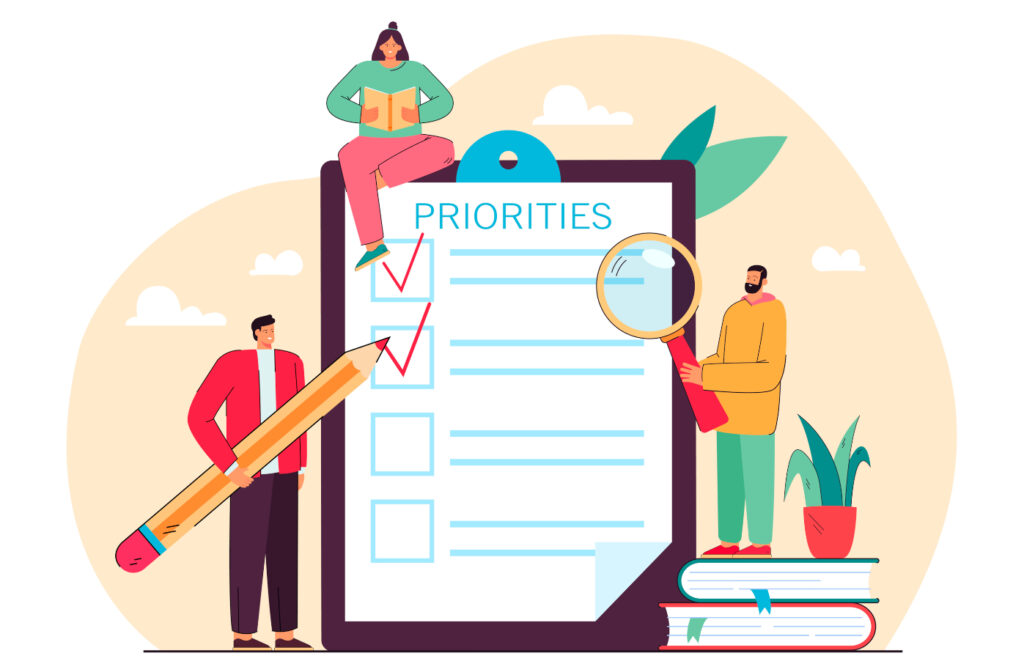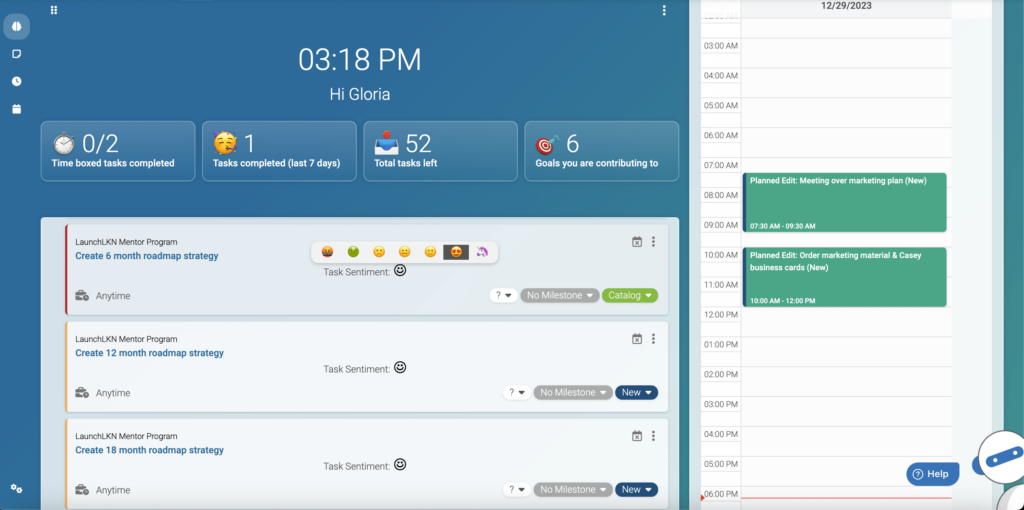Estimated reading time: 14 minutes
We’ve all been there: staring at an ever-growing mountain of tasks, feeling the pressure mount, and wondering where on earth to start.
Prioritizing your workload isn’t just about getting things done; it’s about getting the right things done in the right order. But let’s face it: when everything seems urgent, making those choices can be anything but straightforward.
The good news? You’re not alone in this struggle; there’s a way out of the chaos. Below, we’ll explore 10 practical tips for prioritizing your workload effectively. Whether juggling work deadlines, managing household chores, or trying to squeeze in some personal time, these strategies are here to bring some order to the mayhem.
So, take a deep breath, grab your to-do list, and let’s tackle this challenge together!
Table of Contents
- Understanding Your Goals and Objectives
- Making a Comprehensive To-Do List
- Categorizing Tasks Based on Urgency and Importance
- Evaluating the Time and Materials
- Prioritizing Tasks with the 1-3-5 Rule
- Tools for Effective Planning
- Reviewing and Adapting Regularly
- Harnessing the Power of Effective Communication
- Final Thought
- Frequently Asked Questions
Understanding Your Goals and Objectives
The first and most crucial step is to have a crystal-clear understanding of your goals and objectives. Imagine you’re setting out on a journey; your goals are your destination. What exactly do you want to achieve today, this week, or this year? These could range from meeting project deadlines to long-term aspirations like career advancement or personal development.
Study: Affecting Individual Task Prioritization in a Workplace Setting
Once you’ve pinpointed these goals, it’s time to map the route. This means aligning your daily tasks, those seemingly endless to-dos, with your broader goals. It’s about ensuring that every email you send, every meeting you attend, and every project you take on is a step in the right direction.
Doing so means you’re not just crossing off the highest priority tasks but moving towards your ultimate objectives. So, take the time to reflect, plan, and align – it’s the bedrock of effective workload prioritization.
Work Statistic: 85% of workers spend up to two hours unproductively looking for information related to their work.
Defining Short and Long-Term Goals
Short-term goals refer to targets you plan to achieve soon, such as weekly or monthly objectives. Long-term goals, however, are the objectives you plan to accomplish over a more extended period, such as yearly or multi-year.
By outlining both your short-term and long-term goals, you can clearly understand the direction you want to take and the milestones you need to achieve along the way. This will help you plan better and stay focused on your goals.
Aligning Tasks with Overall Objectives
When you have a clear idea of your goals, it’s crucial to ensure that the tasks you undertake align with these objectives. This involves prioritizing tasks that directly contribute to your goals so that your efforts are focused on what really matters.
When you align your tasks with your objectives, you can organize your workload purposefully and efficiently, leading to greater productivity and success.
Making a Comprehensive To-Do List
To manage your workload effectively, create a comprehensive list of complex tasks that need to be accomplished. This involves gathering all your major and minor tasks and organizing them by priority based on their importance and deadline. The process of creating a task list can be broken down into three categories: daily, weekly, and monthly tasks.
For daily tasks, you should list the ones that have to be completed within that day. This list should be reviewed at the beginning of each day to make sure that you are on track. For weekly tasks, these are the other tasks that need to be completed within the week. Reviewing the list at the beginning of each week helps determine if you have enough time to complete all the tasks.
This list should be reviewed at the beginning of each month for monthly tasks, similar to daily and weekly. You should ensure you have enough time to complete them before their deadline. Taking the time to organize your most urgent tasks into these categories will save you time and allow you to prioritize your workload effectively.
Compiling All Tasks and Responsibilities
Begin by listing all the tasks you need to complete, big and small. This includes ongoing projects, one-off tasks, and any other responsibilities you have. Be thorough in your list-making, as this will help in making certain that no tasks are overlooked or forgotten.
Including Both Major Projects and Minor Tasks
Including major and minor projects in your list is crucial, as even the smaller tasks play a part in achieving your overall objectives and goals. You can create an organized and manageable workload by considering all important tasks, no matter their size or complexity.
Organizing Tasks: Daily, Weekly, and Monthly
After you’ve put together a detailed list of your remaining tasks, it’s time to sort them out based on when they need to be finished. Think about which tasks need your attention today, which ones you should focus on over the week, and what can be planned for the month ahead.
This way of organizing isn’t just about neatness; it’s about giving you a clear, doable plan to tackle your workload.

Categorizing Tasks Based on Urgency and Importance
After compiling a comprehensive list of tasks, it’s essential to categorize them based on their urgency and importance. This process helps you determine which tasks require attention and which can be scheduled for later, allowing you to optimize your efforts and focus on the tasks that are most relevant to your objectives.
Determining the Importance of Tasks
Start by taking a good look at each task on your list and really think about how much it matters in the grand scheme of things.
Ask yourself: How does this task help me get closer to what I want to achieve, both now and down the line?
Those tasks that are necessary for reaching your immediate and future goals deserve your attention and should be at the top of your list. On the other hand, the ones that don’t contribute as much to your big-picture aims can take a back seat for now. It’s all about recognizing what truly matters and giving those tasks the spotlight they deserve.
Related Blog: Effective Task Management Techniques for Individuals with ADHD
Distinguishing between Urgent, Important, Both, or Neither
You’ll want to differentiate between urgent and important tasks alongside assessing their significance. Urgent tasks require immediate attention and have pressing deadlines, while important tasks contribute significantly to your overall goals and objectives. There could be some that are both urgent and important, while some may not be either.
If there are urgent but unimportant tasks, you can either delegate them to someone else or schedule them for later. Finally, items that are neither urgent nor important should be given the lowest priority.
Evaluating the Time and Materials
As you organize your tasks, evaluating the time and materials each one will need is important. This step allows you to distribute your time and resources wisely and not waste time, but it also ensures that you accomplish your tasks in the most efficient way possible. Sometimes, this part can be challenging, but it’s extremely helpful
For every task you’ve listed, take a moment to gauge the time and resources it’ll demand. Think about aspects like how intricate the task is, the skills and know-how it calls for, and any extra hands or tools you might need. Estimating these details helps you sort your tasks by importance and manage your resources efficiently.
Considering Deadlines and Potential Obstacles
In addition to estimating the time and resources needed for each task, it’s important to consider deadlines and potential obstacles. Those with tight deadlines or those that have a significant impact on your overall objectives should be prioritized.
\Additionally, be aware of any potential obstacles that could hinder the completion of a task, such as dependencies on other tasks, resource constraints, or potential bottlenecks. By considering deadlines and potential obstacles, you can ensure that your workload is prioritized in a way that helps you achieve your goals and objectives efficiently.

Prioritizing Tasks with the 1-3-5 Rule
The 1-3-5 Rule is a popular and practical approach for organizing and managing your daily tasks. It is a simple yet effective method that involves categorizing your tasks based on their size and importance. The rule suggests that you should prioritize your workload by focusing on one large task, three medium tasks, and five small, easier tasks each day.
This way, you can ensure that you are progressing on your most significant projects while tackling smaller, more manageable tasks. The 1-3-5 Rule can help you stay organized and productive and can be an excellent tool for anyone looking to optimize their time and workload.
Getting Started with the 1-3-5 Rule
Before starting your day, identify one important and urgent tasks. This item should be a key player in achieving your overall goals and likely needs a good chunk of your time and energy throughout the day.
Next, choose three medium-sized tasks that are important too but won’t take up as much time or effort as the primary one. Finally, assemble five small tasks that you can wrap up swiftly with little effort. This way, you’ll have a well-balanced to-do list that moves you steadily toward your goals.
Focusing on One Task at a Time
Focusing solely on one task at a time allows you to dedicate your full attention to it, providing that you complete it to the best of your ability. This method helps you submerge yourself completely in the task at hand, which boosts efficiency and productivity.
Cutting Back on Multitasking
Sure, juggling multiple tasks at once might feel productive, but studies suggest it can slow you down and lead to more mistakes. [1] Instead, sticking to the 1-3-5 Rule helps you stay focused and organized.
Did You Know: According to research, only 2.5% of people are able to multitask effectively. [2]
By focusing on one big task, three medium ones, and five smaller ones each day, you’ll achieve better outcomes and enjoy greater success.
Tools for Effective Planning
To prioritize your tasks effectively, having a set of tools and strategies at your disposal is helpful to keep you on track and concentrated. Handy resources like Leantime project management software, which offers Kanban boards, time blocking, and calendar tools, can make a big difference.
Using these tools can help you handle your tasks more adeptly, ensuring you’re making steady, efficient progress toward your goals.

Leantime Project Management Software
Leantime is a professional and inclusive project management software designed to cater to the needs of various target audiences, including small business owners, product teams, digital consulting agencies, nonprofit organizations, and more.
The software emphasizes the importance of neurodiversity in the workplace and incorporates AI and behavioral science to enhance productivity and engagement. With its straightforward and user-friendly interface, Leantime makes it easy for users to organize and prioritize tasks, ensuring that they stay on track and focused on their goals.
As a feature, Leantime allows you to import iCal URLs from external calendars such as Google, Apple, and Outlook
Kanban Board
A Kanban board is a convenient visual aid that simplifies organizing and monitoring your tasks, making it easier to manage your projects and prioritize your workload.
It lays out your tasks clearly, letting you instantly see what needs to be done and which tasks need your immediate attention. This clarity helps you keep everything in order and stay focused, paving the way for a boost in productivity and success.
Time Blocking
Another prioritization technique is called time blocking. This time management technique involves allocating specific blocks of time to tasks or activities. By setting aside dedicated time for each important task, you can minimize distractions and ensure that you are working efficiently.
Time blocking also encourages you to focus on one task at a time, reducing the temptation to multitask and allowing you to immerse yourself in the task at hand fully.
Calendar Tool
Utilizing a calendar tool is key to managing your workload smoothly and keeping everything organized. It allows you to schedule tasks, mark deadlines, and distribute your time across different activities, helping you make the most of your resources.
Plus, a calendar tool aids in striking a healthy balance between work and personal life by helping you plan out both professional and personal commitments efficiently.
Reviewing and Adapting Regularly
Effectively prioritizing your workload requires an initial organization of tasks and an ongoing commitment to reviewing and adapting your priorities as needed. This ensures that you remain responsive to changing circumstances and can continually optimize your efforts to achieve your goals.
In order to manage your workload efficiently, it is crucial to prioritize your tasks right from the start. However, it is equally important to review and adapt your priorities on a regular basis.
This helps you stay responsive to changing circumstances and adjust your efforts accordingly, ensuring that you continue to make progress toward your goals. One way to do this is by regularly assessing your tasks and goals to determine whether they are relevant and aligned with your objectives. You can then adjust your priorities based on this analysis.
Also, it is important to remain flexible and open to changes in your workload, as unexpected tasks or urgent deadlines can arise at any time. Regularly reviewing and adapting your workload can optimize your efforts and achieve your goals more efficiently.
Setting Regular Times to Review Priorities
Make it a habit to set regular times to review your task priorities. This could be daily, weekly, or monthly, depending on the nature of your work and the timeframes involved.
Regularly reviewing your priorities helps keep your tasks in line with your overall objectives, allowing you to work effectively towards achieving them.
Adjusting Priorities as Needed
When reviewing your priorities, be ready to tweak them as necessary. This might mean reshuffling the order of tasks, introducing new ones, or dropping tasks that no longer serve your goals. Staying flexible and adaptable helps keep your workload in check and supports steady progress towards your objectives.
Harnessing the Power of Effective Communication
As you prioritize your workload, effective communication plays a vital role in ensuring that you and your team stay on track and work efficiently. By keeping teammates informed of task progress and reducing the number of requests received, you can foster collaboration and productivity in the workplace.
Did You Know: An overwhelming 86% of professionals believe that ineffective communication is the root cause of declining productivity in the workplace. Additionally, 74% of employees feel out of the loop because crucial company information fails to reach them. [3]
Keeping Teammates Informed of Task Progress
Regularly update your team on the status of important tasks, especially those that impact the overall objectives and goals. This can be done through task comments and status updates within a project management tool like Leantime or during team meetings. By proactively sharing task progress, you can prevent misunderstandings, reduce the need for follow-up inquiries, and ensure that everyone is on the same page.
Reducing the Number of Requests Received
Effectively managing your workload also involves reducing the number of requests received from teammates. By providing clear and timely updates on task progress, you can minimize the need for additional requests for information. This helps maintain focus on the tasks at hand and fosters a more streamlined and efficient work environment.
Final Thought
As you can see, the key to prioritizing tasks isn’t just about working harder but about working smarter. By understanding and implementing strategies like setting clear goals, breaking tasks into manageable chunks, and being adaptable to changes, you can increase your productivity and enhance the quality of your work and life.
Remember, how to prioritize tasks it’s all about finding a method that resonates with you and allows you to thrive in your personal and professional endeavors. So, take these tips, tailor them to fit your unique rhythm, and watch as you transform the way you tackle your high-priority tasks, one step at a time.
Frequently Asked Questions
To effectively prioritize your workload, start by making a comprehensive list of all your tasks. Then, categorize them based on their importance and urgency. Focus on completing the most critical and time-sensitive tasks first. Break down large projects into smaller, more manageable steps.
Avoid multitasking and dedicate your full attention to one task at a time. Regularly review and adjust your priorities as new tasks arise or circumstances change. Finally, don’t hesitate to delegate tasks when possible to free up your time and energy for the most important work.
Prioritizing tasks means strategically deciding which tasks are most important and need to be completed first. This involves considering factors like urgency, importance, deadlines, and the potential impact of each task on your goals. By focusing your energy on the highest-priority tasks, you can maximize your productivity and achieve the most important outcomes.
Resources
[1] Madore KP, Wagner AD. Multicosts of Multitasking. Cerebrum. 2019 Apr 1;2019:cer-04-19. PMID: 32206165; PMCID: PMC7075496.
[2] Watson, J. M., & Strayer, D. L. (2010). Supertaskers: Profiles in extraordinary multitasking ability. Psychonomic Bulletin & Review, 17(4), 479–485. View Study
[3] Barraclough, D. (2020, February 6). Amazing Communication in the Workplace Statistics for 2020. Expert Market US. View Resource






